Zinnia elegans



Soft wooded
No secondary (woody) tissue being formed. The texture is fleshy and is soft, easy to cut.
Spreading-ascending
When a plant has stems that gradually grow upwards.This annual has an upright habit with slender stems that form a bushy habit. It has mid green ovate leaves and the large radiate flowers are avaliable in many colours white, pink, red, lavender and apricot appearing throughout summer above the foliage.
Zinnia elegans is naturally found in Mexico, North America growing in deciduous forests, grasslands and along desert fringes at an altitude from 600 m (1,968 ft) to 1,800 m (5,905 ft). It prefers a very well drained sandy to loamy soil that is fertile with a pH range from 5.5 to 7.5. It grows in an open sunny wind protected position and is drought tolerant, preferring hot dry summers but is frost tender and dislikes humidity.
Zinnia elegans is grown for its flowers and is planted in small or cottage gardens along low borders or mass planted in bedding displays in parks or public places. It is suitable for coastal or inland regions and establishes in one season. It is also grown in containers or planted in rockeries and uses in tropical gardens. The flowers are cut for floral arrangements. Once established it has a medium water requirement, (Scale: 2-drops from 3) preferring organic rich moist to dry soil and will tolerate dry periods.
I.D. 305
UK hardiness zone H3
Climate zones 1 - 24, H1, H2
Zinnia (ZIN-ee-a) elegans (AY-le-gahnz)
'Zinnia': after German botanist Professor J.G. Zinn; 'elegans': handsome or tasteful (refers to the tidy habit).
There are many cultivars, please contact your local nursery for available varieties.
Cultivars
Tall strains grow to 70 to 80 cm
'Californian Giants'
'Dahlia-flowered'
'Gold Medal'
'Brilliant Giants'
'Scarlet Ruffles'
Medium grows to 50 to 60 cm (2 ft)
'Burpeeana Super Giant'
'Carousel'
'Envy'
'Fantasy'
'Fruit Bowl'
'Sprite'
Dwarf cultivars grow to 20 to 45 cm (18 in)
'Buttons'
This plant grows to 30 cm (1 ft).
'Lilliput'
This plant grows to 45 cm (18 in).
'Peter Pan'
This plant grows to 30 cm (1 ft).
'Tetra Giants'
This plant grows to 15 cm (6 in).
'Tetra Ruffled'
This plant grows to 15 cm (6 in).
'Thumbelina'
This plant grows to 15 cm (6 in).
Asteraceae (ass-ter-AY-see-ee)
(Compositae)
Sunflower Family
This family is recognised by several features the florets are clustered in the flower head, inferior ovary has one basal ovule and the stamens are connate around the style.
Distribution
This family is found throughout the world except Antarctica. In Australia they are found in arid and semi-arid regions covering large areas.
Diagnostic Features
There are numerous growth forms from small annual herbs, ephemeral, biennial or perennial rosette plants, shrubs but rarely creepers.
The leaves do not have stipules and may be arranged opposite or alternate with margins that are entire to deeply lobed. The texture may be leathery or succulent and may be reduced to spins or needles.
The simple flower is in a tight inflorescence with many florets that sit on a fleshy receptacle that is surrounded by many involucral bracts. In some genera the bracts are reduced or not present and the receptacle may be in an elongated form giving it a club-shape inflorescence.
Each flower has an inferior ovary normally with a colourful corolla on top with the calyx reduced to scales, bristle or hairs around the corolla.
Three distinctive Floret Types.
1. Disk florets are funnel form corolla tube that has five equal lobes with fertile stamens and ovary.
2. The ligulate florets with a corolla that is split down one side and the limb formed is extended to form showy ray florets. These flowers are unisexual.
3. The filiform florets come from disk florets when the corolla tube is a slim cylindrical shape and these are normally unisexual.
The fruit produced from the different types is normally a cypsela (type of achene) although some florets don't produce fruit.
The corolla has five petals, which are five lobes in disk florets but are not easily seen in other types.
The stamens are arranged alternate with the petals and the filaments are normally fused to the corolla tube with the anthers arranged around the style in a connate form.
When the pollen falls onto the closed stigma the style elongates above the stamens and then the stigma opens to be pollinated.
The ovary is inferior with one chamber and one ovule and forms a one seeded fruit, which is really an indehiscent fruit (cypsela). These are normally distributed by animals with barbs formed by the pappus and some by wind.
Note:
This is one of the largest families but with low economic importance. They are used in the horticulture industry largely for cut flowers and in the case of sunflowers for seed oil. Many species are grown in domestic gardens and many have become weeds that are wide spread throughout the world.
This plant tolerates between USDA zones 8a to 11a and grows to 1 m (3 ft)
Fahrenheit 10º to 45º F
These temperatures represent the lowest average
Celsius -9.5º to 7.2º C
Attention
All photographs and data are covered by copyright. Apart from any fair dealing for the purpose of private study, research, reference or review, as permitted under the Copyright Act, no part may be reproduced by any means with out written permission. All inquiries should be addressed to plantfile.com attention Peter Kirkland.

Simple
The leaf that is not divided.
Ovate
The leaf that is broadest at the base tapering towards the apex.
Opposite
Leaves that are arranged opposite to each other.
Entire
A leaf margin with no irregularities (smooth).
Tubulate
A flower that forms a tube shape.
Capitulum
Sessile florets on a flattened and expanded apex (a daisy-like flower). Ray florets can be absent.| Jan | Feb | Mar | Apr | May | Jun |
| Jul | Aug | Sep | Oct | Nov | Dec |
The flowers are single or double with overlapping ray florets and are up to 200 mm (7 ¾ in) wide They are available in a variety of colours and appear from late spring to autumn.
Note; The compressed inflorescence is called the capitulum or flower head and is composed at the base with a receptacle (involucre) that has one to several rows of bracts that may be spiny. The bisexual or unisexual flowers are attached to the receptacle. The ray florets have a corolla tube that is slit along one side with a Ligule (single petal) normally extend out around the rim giving the flower head a daisy-like appearance. (May be absent in some genus) There are many tubular disk florets in the centre of the flower head and they have 3-5 equal lobes.
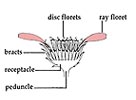

Cypsela
An achene with a thin leathery pericarp and a parachute-like pappus."Zinnia elegans is grown for its flowers and is planted in small or cottage gardens along low borders or mass planted in bedding displays in parks or public places. It is suitable for coastal or inland regions and establishes in one season. It is also grown in containers or planted in rockeries and uses in tropical gardens. The flowers are cut for floral arrangements.
Best planted during spring. The Dwarfs grow to 20 - 45 cm, Medium 55 - 65 cm and giants to 70 - 100 cm.
Note:
This plant is susceptible to Bacterial Wilt, Spotted Wilt Virus, Leaf Spot, Powdery Mildew and Sclerotinia Rot.
Sow fresh seeds in warm areas during early spring and in cool areas during mid-spring to early summer in boxes under glass. Pricked out when large enough to handle and pot up or plant out. It takes 12 weeks to produce flowers from seed.
Propagation by Seed (General)
Germination
In order for a seed to germinate it must fulfil three conditions.
1. The embryo must be alive (a viable seed).
2. The seed must have no dormancy-inducing physiological, physical or chemical barrier to germination; also the seed must be nondormant.
3. The seed must have the appropriate environmental requirements, water, temperature and oxygen.
The interaction between these requirements and dormancy is complex and may lead to different environmental requirements that avoid the dormancy of a seed.
Sowing Seeds in Containers
There are two general methods for germinating seeds.
1. Sowing seeds in a flat or germinating bed, through which seedlings are pricked-out then, transplanted into another flat with wider spacing or directly to an individual pot.
2. Sowing seeds by placing them in to flats with the appropriate spacing or into individual pots.
This method is normally carried out with medium to large seeds such as woody plants and plants that are difficult to transplant.
Seedling production normally occurs in a greenhouse / glasshouse, cold frames and on hot beds.
Method of Seed Sowing
Fine seed is sown in pots or flats that are no deeper than 70 to 80 mm. using a sterilised well-drained media (soil). Fill the container to 20 mm from the top and sprinkle sieved peat to 3 mm depth.
Press the media down level and firm with a piece of timber and then thoroughly moisten.
Mix the fine seed with washed sand and then sow thinly on the surface. These may be lightly covered with sand.
Larger seeds may be covered with media or a hole is dibbled and the seed is placed in the media.
Watering Methods
For watering you may either mist the containers from above or place the container in tepid water and allow the water to raise through the pot to the surface of the media, then drain away and do not fill to the top of the container.
Place a piece of glass over the pot and store in a protected warm environment (glasshouse).
Seeds germinate best in darkness so shade the containers if in direct sunlight.
After the seedlings have sprouted remove the glass and ease the seedlings into direct light.
When the seedlings are large enough prick them out and transplant into larger containers then place them in a shade house to harden off.
Many seeds have different methods of seed preparation for germination such as nicking or cutting the seed coat to allow water penetration, also placing seeds in hot water and allowing it to cool off.
This is particularly important as it is softening the seed coat.
PEST
NAME
Aphids
Various Aphid Species
ORDER
Hemiptera
FAMILY
Aphididae
Description of the Pest
The common name varies and aphids may be referred to as black fly, greenfly, ant cows or plant lice.
These small insects have soft globular body that is from 1mm to 8mm long and vary in colour from green, yellow, black and pink, with the winged forms being elongated. Both adult and nymphs, have piercing and sucking mouthparts.
Aphids are found on buds, flowers, or leaves and stems, preferring soft new growth. On older leaves the aphids are found in protected positions, such as under the leaf. Certain species of aphids form galls as they suck sap and may be found on the roots of the plant. (E.g. Woolly aphids and Black peach aphids)
Most aphids possess a pair of characteristic tubular projections, known as cornicles; these secrete a pheromone and a waxy fluid, which is thought to protect them from some of their predacious enemies.
White exoskeletons, honey dew and sooty mould indicate the presence of Aphids
Balsam Twig Aphid (Mindarus abietinus) is greenish and covered in a white wax and is normally found on the young shoots of conifers bending and killing the needles. It is found on Abies and Picea species.
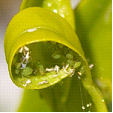 Aphid and their exoskeletons
Aphid and their exoskeletons 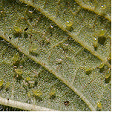 on underside of a leaf
on underside of a leaf
Black Citrus Aphid (Toxoptera aurantii) has a soft plump green body and the black coloured adults may or may not be winged. They feed in groups, curling leaves and producing honeydew attracting sooty mould.
Green Peach Aphid (Myzus persicae) is a soft plump green insect up to 0.2mm long and may be wingless. The nymphs are yellowish green and are responsible for spreading viruses in Dianthus species.
Spruce Gall Aphid (Chermes abietis) form cone shaped galls up to 12mm long resulting from the feeding. The wingless female adult lays eggs on the stems and the immature females overwinter on bud scales. Large infestation will weaken trees such as Picea abies and Pseudotsuga menziesii.
Tulip Bulb Aphid (Anuraphis tulipae) is small, waxy grey coloured and infests the underside of the bulb scales or rhizomes. They occur in the ground or on above ground parts and during storage.
Life Cycle
These insects have a Hemimetabolous life cycle, i.e. The nymphs resemble the adults.
During spring all eggs produced hatch as female nymphs. Adult Aphids are capable reproducing without fertilisation. The males are only produced in some species as the weather cools down, and the day length shortens.
Aphids are capable of giving birth to living young and large populations build up quickly during summer. Over crowding causes the aphids to become smaller, less fertile and produce more winged forms that can migrate to other host plants.
There are many different types of aphids and the life cycle varies from warm to cold climates.
Typical life cycles

Distribution of the Pest
World wide
Period of Activity
In warm climates they are seen throughout the year, but aphids dislike hot dry or cold conditions and heavy rain will decrease the population. In cold areas aphid eggs are laid around a bud base or other protected areas of the plant during autumn and emerge as nymphs during spring, feeding on the new growth.
Numbers build up quickly in the warmer months of the year. Some species feed during winter on Sow thistles.
Susceptible Plants
There is a wide range of plants attacked, from roses to vegetables, shrubs and trees. Certain aphids attack a specific genus while others have a wide range of host plants. Many are capable of transmitting plant virus diseases.
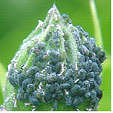 Adults and nymphs feeding
Adults and nymphs feeding 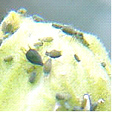 A colony of aphids
A colony of aphids
Acer species are attacked by several aphids including the Norway Maple Aphid (Periphyllus lyropictus) which is a greenish with brown markings and secret honeydew, preferring Acer platanoides. Other aphids include (Drepanaphis acerifolia) and (Periphyllus aceris) which are commonly found on the underside of leaves.
Acer species are also attacked by the Woolly Maple Aphid (Phenacoccus acericola) which covers the undersides of the leaves with a cotton-like mass
Alnus species are infested with the Alder Blight Aphid (Prociphilus tessellates) which is blue-black adult that forms woolly masses on the down-turned leaves. The nymphs overwinter in bark crevices.
Aquilegia species are attacked by several aphids including (Pergandeidia trirhoda) which is a small, flat cream coloured insect that is found on young branches and the underside of leaves.
Betula species may be attacked by the European Birch Aphid (Euceraphis betulae) which is small and yellowish or the Common Birch Aphid (Calaphis betulaecolens) which is large and green producing ample honeydew for sooty mold to grow on.
Callistephus species may be attacked by the Corn Root Aphid (Anuraphis maidi-radicis) causing the plant to become stunted, the leaves wilt and turn yellow. The aphids feed on the roots producing honeydew and are dispersed to other host by ants. It is also attacked by the Potato Aphid (Macrosiphum solanifolii).
Carya species are attacked by Gall Aphids (Phylloxera caryaecaulis) which is found on the leaves, twigs and stems forming galls and turning them black.
Chaenomeles and Gladiolus species, new growth and leaves become infested with the aphid (Aphis Gossypii)
Cupressus macrocarpa may become infested with the Cypress Aphid (Siphonartrophia cupressi).
Cyclamen species are attacked by the aphid (Myzus circumflexus) and (Aphis gossypii) which can infest healthy plants.
Dendranthema, Dianthus and Crocus species are attacked by several types of aphid including the Green Peach Aphid (Myzus persicae) and the Chrysanthemum Aphid (Macrosiphoniella sanborni).
Hibiscus species are attacked by the aphids (Aphis craccivora) and (Aphis gossypii), both congregate towards the branch tips and may cause leaf curl. Normally only seen in sub-tropical climates.
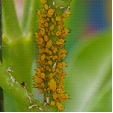 Aphids on a stem
Aphids on a stem 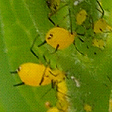 Mandevilla species
Mandevilla species
Larix species is attacked by the Woolly Larch Aphid (Adelges strobilobius). The winged adults deposit eggs at the base of the needles during spring and white woolly areas appear attached to the needles where the adult aphids feed. The young aphids overwinter in the crevices of the bark.
Mandevilla species is attacked by aphids that congregate towards the branch tips and may cause leaf curl.
Pinus species is attacked by several species of aphid including Pine Bark Aphid (Pineus strobi), Pine leaf Aphid (Pineus pinifoliae) and the White Pine Aphid (Cinara strobi).
Primula species are attacked by four species of aphid including foxglove, and green peach aphid.
Rudbeckia, Delphinium, Chrysanthemum and Helianthus species are attacked by a bright red aphid (Macrosiphum rudbeckiae).
Sorbus aucuparia is affected by the Rosy Apple and Woolly Apple aphid which attacked the foliage and young shoots.
Spiraea species are attacked by the Aphid (Aphis spiraecola) which feeds on the young shoots and flowers.
Tropaeolum species are attacked by the Black Bean Aphid (Aphis fabae), which is found in large numbers on the underside of the leaves, turning them yellow and causing them to wilt then die.
Tulipa, Iris, Freesia, Gladiolus and Zephyranthes species are infested with the Tulip Bulb Aphid.
Ulmus species are infected by two types the Woolly Apple Aphid (Eriosoma lanigerum), which curls and kills young terminal leaves and the Elm Leaf-Curl Aphid (Eriosoma ulmi) which occasionally attacks the trees.
Viburnum species are attacked by the Snowball Aphid (Anuraphis viburnicola). This aphid congregates at the end of the branches causing the leaves to curl and become deformed under which they hide.
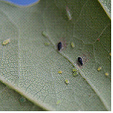 Aphids on Quercus robur
Aphids on Quercus robur
Damage Caused
Buds that have been attacked may not open, leaves and twigs become twisted or distorted and wilt. The aphids also produce honeydew, which is sticky and attracts sooty mould (fungus). This fungus forms a thick layer over the leaf, fruit or stems reducing the plants photosynthesis capability. The sooty mould spoils the plants appearance and its fruit, as does the insects white exoskeletons.
Control
Cultural Control
Aphids may be removed from a plant by hosing them off with water (limited success) or applying soapy water to aphids.. Another organic sprays can be efficient in controlling aphids. Aphids may also be removed physically by hand for small colonies on spine less plants. Species that live under ground are difficult to control but cultivation of the surrounding soil may help in controlling the infestation. (limited mainly to annual or commercial crops)
Reflective mulch around the plants also reduces numbers by repelling the insect this material is available commercially. (Reflective mulches are mainly used in market gardens for avoiding the Green peach Aphids) Resistant rootstocks are available to avoid some root feeding aphid of commercial plants, e.g. Vines and fruit trees
Biological control
Aphids are attacked by several insects includes parasitic wasps or predators such as ladybirds/ lady beetles, hover flies, lacewings, spiders.
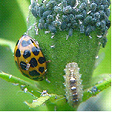
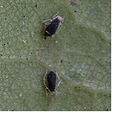 Parasitised aphids
Parasitised aphids
Chemical Control
Aphids may be controlled by spraying with a contact or systemic insecticide. The type of application used will depend on the plant is being attacked.
Aphids can be suffocated and therefore controlled with the use of e.g. White oil, Pest oil, Soapy water from soap such as Lux Flakes ®
Note
It is your responsibility by law to read & follow the directions on the label of any pesticide
Monitoring
Aphid are attracted by yellow colour and traps such as boards painted yellow and covered in glue or sticky substance will attract and trap the insects. There is also a commercially sticky yellow tape that can be attached to susceptible plants
Amendments by B. Sonsie Dip Hort Sc Burnley
PEST
NAME
Budworms
Helicoverpa species
ORDER
Lepidoptera
FAMILY
Noctuidae
Description of the Pest
Mature larvae are caterpillars up to 45 mm long; colour varies from yellowish-green to reddish-brown, most with stripes or darker body markings. Female moths have a wingspan up to 40 mm across, are reddish brown in colour; hindwings are pale at the base and dark along the edges.
Moths of Heliothis are very similar to that Helicoverpa armigera (Corn earworm).
Helicoverpa have a spot which is kidney shaped in the centre of the forewing,
The Adults of all species are attracted to lights at night.
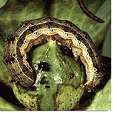
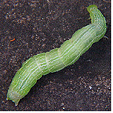
The larvae are smooth and vary in colour but have light coloured strips
Life Cycle
This insect has a Holometabolous life cycle, i.e. it has a larval and a pupal stage.
Females lay up to 1000 tiny white eggs, deposited singly, on the young growth of host plants.
Larvae pupate in the topsoil, after feeding for 2-3 weeks; the emergence of adults is triggered by appropriate moisture & temperature conditions during Spring. Long periods of cold and drought can delay the emergence of the adult moths for up to 5 months.
There are two main periods of infestation early summer and autumn.
Distribution of the Pest
Helicoverpa species (Heliothis species) are found throughout Australia.
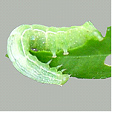
Larvae have prominent prolegs
Period of Activity
Most active in Spring and Summer, after good rainfall and vigorous plant growth.
Damage Caused
Larvae attack chew on new growth, fruit, seed and flower buds. Fruit and flowers are damaged and yield is reduced. Entry holes in fruit enlarge and become more obvious as the caterpillar matures.
Bud worms which feed inside the flower buds can cause the buds to brown and not open.
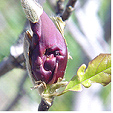
Damage to a flower bud
Susceptible Plants
Attacks a wide range of fruiting and ornamentals plants, such as gardenias, carnations, roses, calendula, hollyhocks, snapdragons, etc. This is a major pest of commercially grown tomatoes, beans,
sweet corn, cotton, sorghum and peas.
Pseudotsuga menziesii, Picea, Pinus, Pseudolarix and Tsuga species are attacked by the Spruce Budworm (Choristoneura fumiferana). Symptoms include the new opening buds and needles are eaten by the dark red caterpillar that has a yellow stripe along its side. It is a serious pest to ornamental and forest trees and control is difficult.
Control
Cultural Control
It is difficult to control bud-worms once they enter the fruit or buds so it important to apply clay and pepper sprays or pyrethrum, while the young lava are feeding on the leaves. Caterpillars may be removed by hand or infested flowers and fruit removed from the plant.
Biological Control
Genetically modified crops have been developed for cotton.
A virus NPV may be commercially available for cotton growers to control Helicoverpa armigera and H punctigera
Helicoverpa armigera & Helicoverpa punctigera), are parasitised by many different insects, including Chaetophthalmus dorsalis flies from the Tachinidae family.
Egg parasites include Trichogramma & Telenomus wasps
Larval parasites include Micrropilitis demolitor, Netelia producta and Trachnid flies
Larval pupa parasites include Heteropelma scaposum and Lissopimpla excelsa
Pupal parasites include Ichneumon promissorius
Chemical Control
Control needs to occur before the larvae enter the fruit or flowers.
Note
It is your responsibility by law to read & follow the directions on the label of any pesticide
Monitoring
Shake plants twice a week on to a stiff white cardboard, once they start flowering.
Other Common Names; includes
Native Budworm (Helicoverpa punctigera) Tomato grub, Cotton bollworm, Corn ear worm, Tobacco budworm
Amendments by B. Sonsie Dip Hort Sc Burnley
PEST
NAME
Thrips (General)
Various Thrip Species
ORDER
Thysanoptera
Description of the Pest
There are many species of thrips that attack living and dead plant material. The winged adults are black, yellow, white or brown with slender bodies and up to 2mm long. The folded fringed wings appear as silvery stripes and the smaller nymphs are difficult to see, but are wingless simular to the adults. Both adults and the first two nymphal stages have rasping and sucking mouthparts.
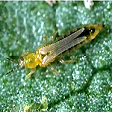 Thrip species
Thrip species
Boree Gall (Kladothrips species) adults are gall producing thrips that form smooth bubble-like or irregular spiny growths on the leaves. These galls can contain up to 1000 insects that also reproduce inside, and are trapped until the gall dries or splits open. Commonly found in inland areas attacking the phyllodes of Acacia species.
Glasshouse Thrips (Heliothrips haemorrhoidalis) is a slender up to 15mm long with small fringed wings. The adult lays eggs on the underside of leaves where the nymphs emerge as miniature adults but wingless. Then feed on the soft leaves leaving a silvery mottled appearance.
Appearance and Distribution of the Pest
Thrips are found from tropical to temperate regions preferring a cool mild winter followed by a dry sunny spring that produces abundant flowers and new foliage. It is dispersed by flying and can be carries great distances on the wind.
Life Cycle
These insects have a Hemimetabolous life cycle, ie. When the immature nymphs resemble the adults.
The female adult lays her eggs using an oviposit in a slit on flower stems or occasionally leaves. The eggs develop into four nymphal stages. The first two stages occur on the plant and the last two in the surrounding soil or in leaf litter, emerging as adults and flying to reinfect the plant. It takes ten to thirty days to develop from egg to adult depending on the temperature and rainfall. Under opium conditions thrips are produced in plague proportions.
Period of Activity
Thrips are most active during warm dry, calm weather, but dislike the soil to be too dry or wet.
Damage Caused
Thrips congregate inside the flowers damaging the epidermal layer, allowing sap to leak out. This causes the flower petals to become brownish and curl along the margins. They also attack the upper surface of leaves causing a silvery discolouration as they suck the sap. The effect is a reduction in fruit and seed production on the host plant.
Susceptible Plants
Generally many plants species are attacked by thrips including buds, petals and leaves that are soft are at most risk, such as Alyogyne , Baeckea, Hibbertia, Hibiscus and Leptospermum species. There is also a wide range of ornamentals suseptable to attack including apples, pears, citrus, stonefruit, grapes and strawberries.
Buddleja species may be attacked by the thrip (Hercinothrips femoralis).
Cordyline, Agave, Dracaena and Howea species, Ficus elastica are attacked by the Dracaena Thrips (Parthenothrips dracaenae) which feed of the leaves.
Knightia excelsa is attacked by thrips by feeding on the chlorophyll in the leaf causing significant paling of the leaves. Stresses plants are more susceptible and plants rarely die from attack.
Peperomia, Cissus, Tropaeolum and Passiflora species and some fern species are attacked by Glasshouse Thrips which can cause heavy damage in inclosed areas such as a glasshouse.
Watsonia species are attacked by the Gladiolus Thrips (Taeniothrips simplex).
Cultural Control
There is no satisfactory cultural control. Small infestations may be ignored or the plant may be hosed to reduce the numbers. Removal of surrounding leaf litter, weeds and cultivating the soil can also reduce the numbers and disturb the life cycle. Care should be taken not to remove flowering weeds under trees that are in bloom as the thrips may migrate on to the tree, alternatively flowering annuals can be planted under trees to attract the thrips away.
Biological Control
No effective natural control though birds; wasp and other predators eat thrips. Weather conditions such as heavy rain help reduces numbers.
Chemical Control
Thrips can be sprayed with Dimethoate or Maldison at least twice every ten days to kill newly hatched nymphs, but may have a detrimental effect on other insects such as bees.
Note
Always read the label for registration details and direction of use prior to application of any chemicals.
PEST
NAME
Caterpillars (General)
Various species
Description of the Pest
There are many types of caterpillars from moths or butterflies, cutworms, bag moths, case moths, leaf rollers leaf skeletonises. The larvae generally eat leaves, seeds, flowers or buds by chewing out pieces. The size of the piece will depend on the size of the caterpillar and generally they are voracious eaters. The method of eating varies such as the leaf skeletoniser which leaves a network of veins or whole leaves are consumed.
The larvae have mainly 4 or 5 pairs of prolegs except Loopers which have 2 -3 pairs of prolegs. The number of prolegs can help in identifying the insect.
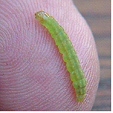 Small and Large Types
Small and Large Types 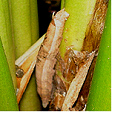
Casuarina Moth (Pernattia exposita) is gregarious, brown with a large head and tufts of hairs that line the slender body. It grows to 25 mm long and forms a tightly woven cocoon on the side of branchlets. The large female adult moth has a stocky body and generally slow moving, the male is smaller.
The larvae cause extensive damage to A. littoralis, A. stricta, C. cunninghamiana, C. glauca, and C. equisetifolia.
The hairy larva feed on the 'leaves" phyllodes, and stems, this can lead to ringbarking and death of branches.
Monitoring
Place sheets on the ground and disturb (shake) the tree for the larva drop to the ground on silken threads.
Spruce Budworm (Choristoneura fumiferana) is a reddish brown with a yellow stripe on its side and chews on the opening buds and the needles of the host. The adult moth is dull grey with brown bands and spots on the wings, appearing in early summer. The larva is very destructive in northern hemisphere coniferous forests.
Banksia Moth (Danima banksiae) is a caterpillar up to 60 mm long and is brown with black and white markings on its sides and when disturbed it arch backwards and reveal an extruded red underside, close to its head. The grey adult moth has an orange coloured body with a wing span that is up to 80mm across with black and white markings.
Banana moth (Opogona sacchari) is in the order Lepidoptera. This nocturnal moth as a wing span up to 25 mm wide and is bright yellowish brown with a dark brown spot on the wings. It has a life cycle that lasts approximately 3 months with the eggs hatching in 12 days and the whitish larva with a reddish brown head is up to, 26 mm long, and lives for 50 days at 15° C. In warmer climates life cycle is quicker with up to eight generations per season. The female moth uses a ovipositor to lay up to 500 eggs in groups of five amongst the crevices of the plant. The voracious larvae tunnel into the plant, avoiding light. In bananas it infests developing fruit and in ornamental plants it prefers the fleshy stems, particularly in cacti, begonias, African violets and is also a serious pest of Pritchardia and Chamaedorea species. Symptoms include tunnelling activity, which may be difficult to see then dead areas appear on the stems. As the caterpillars destroyed xylem tubes leaves begin to wilt and the plant may collapse and die. In European countries it is a glasshouse pest that is controlled chemically.
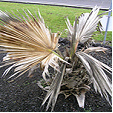 Pritchardi species
Pritchardi species 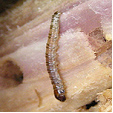 Banana moth larvae
Banana moth larvae
European Pine Shoot Moth (Rhyacionia buoliana) lays eggs on Pinus species during late spring on the new buds and the emerging caterpillars in late summer feed on the shoots causing them to fold and become deformed, eventually dieing. A major problem in the pine forests of the northern hemisphere
Large Grass Yellow Butterfly (Eurema hecabe) is a small attractive yellow butterfly. with a wing span of 40 mm that lays its eggs on the feathery leaves on Acacia species such as A. baileyana, (Cootamundra wattle), A. spectabilis (glory wattle). Other plant foods include Cassia spp, Caesalpinia spp, Senna spp. Albizia julibrissin (silk tree) A. paraserianthes (Albizia) sp Aeschynomene sp (Budda pea), Indigofera australis (Australian indigo's), Sesbania cannabina (yellow pea-bush), Senna surattensis (Glossy shower), Leucaena leucocephala (wild tamarind).
The small lava are up to 15mm long, green with white lateral bands and feed on the leaves at night in small groups, hiding under the leaves during the day. Large infestations may strip trees and require control. The larva of this insect does not feed on grasses. The adults are important pollinators of many Australian native plants. Various sub species of this insect are found through out Asia.
Gypsy Moth (Porthetria dispar) lava is a hairy grey caterpillar that is marked with blue and red dots along its back and can grow to 75mm long. It is capable of defoliating large trees and is a major problem for several species. A major problem in the northern hemisphere.
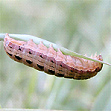 Lawn Armyworm
Lawn Armyworm
Lawn Armyworm (Spodoptera mauritia) is a plump, smooth caterpillar that is darkish brown to black with multiple stripes and pattens along its body. It can grow to 50mm long and tapers from the head. They are gregarious and move around in groups, like an army. If disturbed the larva drop to the ground and curl up, "faking death" The larva pupate in the soil. They are a pest of grasses and monocotyledon crops mainly.
This insect is also found throughout Asia.
Monitoring
Drench a known area with old fashion soap 2L / 1000 cm 2. Note the numbers of larvae emerging.
Oblique-banded Leaf Roller (Choristoneura roseceana) lava feeds on the leaves and forms a nest by drawing the leaf margins together using silk threads. The adult moth is up to 25mm across the wingspan and is reddish brown with three darker brown bands across the wings. This is a problem in the apple growing areas of North America. It feeds on Maples, hawthorns, crab apples, Blackberry (bramble) and raspberries.
Red Humped Caterpillar (Schizura concinna) is a lava has a red head and humps with yellow and black strips on the body. It grows from eggs that were laid on the underside of leaves by the adult greyish brown moth that has a wing span up to 30mm across.
Tailed Emperor Caterpillar (Polyura pyrrhus spp. sempronius) adult is a large butterfly with a wing span up to 110 mm with four long tapering tails and the rear of the wings. The fleshy caterpillar with four obvious backward facing horns on a shield shape head. It is dark green with yellowish bands and transversal stripes over its back and grows up to 80 mm in length.
It is commonly found solitary or in small groups. Found over much on mainland Australia. The adults are attracted to overripe fruits they become drunk on this and so are easy to capture. The larvae feed on many plants including, Acacia baileyana (Cootamundra Wattle, A. spectabilis (Glory wattle), Delonix regia (Poinciana), Cinnamomum camphora (Camphor laurel) Robinia pseudoacacia (Black or false locust) Lagerstroemia indica (Crepe Myrtle), Argyrodendron actinophyllum (Black booyong), Celtis spp (Hackberry), Brachychiton spp (Kurrajongs) Gleditsia triacanthos (Honey locust).
Verbena Moth (Crambodes talidiformis) lays its eggs on the outside of the plant and the small green caterpillar that attacks seed pods by entering and eating the contents. It half emerges while pupating appearing as a small brown bump circled by a black ring. Native to North America
White Tussock Moth (Hemerocampa leucostigma) produces lava that is up to 50mm long. It has a red head with a yellow body that is marked in black and has four tufts of hair. The caterpillars pupate on the branches and the eggs laid by the adult moth overwinter on the trunk and are covered in a white waxy material. They are found on Aesculus species. A pest in North America of Oaks.
Life Cycle
This insect has a Holometabolous life cycle, i.e. it has a larval and a pupal stage.
Distribution of the Pest
Many species are found throughout the world from tropical to temperate regions and most of the adults are capable of by flying
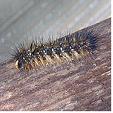 Many hairy caterpillars can be irritating
Many hairy caterpillars can be irritating 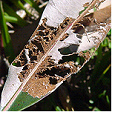 Leaf Skeletonised
Leaf Skeletonised
Period of Activity
Most active during the warmer months from spring to autumn.
.
Damage Caused
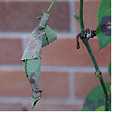 Leaf Rollers
Leaf Rollers
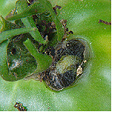 Caterpillar Inside a Tomato
Caterpillar Inside a Tomato
Susceptible Plants
A wide range of native and exotic plants are attacked and can be a major problem in commercial crops or turf grasses. Plants with soft-textured foliage (eg vegetables, some indoor plants) are preferred, but trees and shrubs are commonly attacked.
Malvaceae Abutilon spp, Hibiscus spp and other members of the family are attacked by the castor oil looper, Croton caterpillar (Achaea janata) which feed on leaves. The tip borer Cotton tipworm (Crocidosema plebejana), Rough bollworm (Earias huegeliana) which feeds on young stems, flowers and seeds. A leaf miner (Phyllonorycter spp)
Acer saccharinum and Fagus species are attacked in North America by the Maple Leafcutter (Paraclemensia acerifoliella) that forms a small cocoon in leaves that it skeletonises.
In Australia Case moths and Painted apple moths (Teia anartoides)
Ailanthus altissima is attacked by the Cynthia Moth (Samia cynthia) light green lava, which eats leaves and the Ailanthus Webworm (Atteva aurea) which are olive-brown caterpillars that form web nests in the leaves.
Antirrhinum species are attacked by the Leaf Tier (Udea rubigalis) lava. This caterpillar eats pieces out of leaves and binds them together forming a nest. It is more commonly found in glasshouse culture.
Berberis species may become infested with the Barberry Worm (Omphalocera dentosa). This small caterpillar is black with white spots, up to 14mm long and feeds on young shoots and leaves. It also binds the shoots with a silken thread to form a nest.
Betula species are attacked by the Leaf Skeletonizer (Bucculatrix canadensiella). The small adult moth has brown wings with a whitish underside and its yellow green, 7mm long lava skeletonise the undersides of the leaf turning it brown.
Brachychiton, Senna and feathery-leaved Acacia species are attacked by the Tailed Emperor Caterpillar, particularly in dryer periods.
Catalpa species are attacked Catalpa Sphinx (Ceratomia catalpae). This large yellow and black Caterpillar grows to 76mm long and attacks the leaves. Large infestations can completely stripped a tree and control is carried out by spraying.
Calendula and Canna species are attacked by the Woollybear Caterpillar (Diacrisia virginica) which has yellow and black lines down its body is up to 50mm long and eats the leaves or flower buds. In Canna species the chewed holes tend to be in a straight line across the leaf.
Celtis species are attacked by the Spiny Caterpillar (Nymphalis antiopa) which is reddish, up to 50mm long and feeds on the leaves at the top of branched in groups.
Cheiranthus species are attacked by the Diamond-backed Moth (Plutella maculipennis) lava, which is a small green caterpillar to 14mm long that feeds on the underside of leaves and may form a shot hole appearance. It forms a small cocoon to pupate in and in cooler climates it may be found in glasshouses.
Cotinus, Fraxinus, Betula, Cornus, Crataegus, Aesculus, Tilia, Acer, Quercus and Populus species are susceptible to attacked by the Oblique-banded Leaf Roller (Archips rosaceana)
Iris and Antirrhinum species are attacked by Verbena Moth.
Picea, Abies, Tsuga and Pinus species are attacked by Budworm commonly found in the northern hemisphere.
Populus and Carya species are attacked by the Red Humped Caterpillar which chews the leaves.
Quercus species are attacked by several caterpillars including Saddleback Caterpillar (Sibine stimulea) and Datana Caterpillar (Datana ministra) that feed on the leaves.
Samanea saman is attacked by several caterpillars (Ascalapha odorata, Polydesma indomita and Melipotis indomita). These caterpillars defoliate the tree but cause no long term problems.
Spiraea, Fraxinus, Betula, Cornus, Crateagus, Acer, Quercus and Populus species are attacked by the Oblique-banded Leaf Roller.
Ulmus, Salix, Crateagus, Tilia, Quercus and Populus species, Pseudotsuga menziesii are attacked by the Gypsy Moth (Porthetria dispar).
Ulmus species are attacked by the Spring Cankerworm (Paleacrita vernata), which chews the leaves during spring and the Fall Cankerworm (Alosphila pometaria), which also eats the leaves during autumn. Ulmus species are also attacked by several caterpillars including the lava of the Leopard Moth (Zeuzera pyrina) and the Tussock Moth (Hemerocampa leucostigma).
Cultural Control
Small numbers may be removed by hand and squashed while others species such as the Casuarina Caterpillar drop to the ground when disturbed by hitting with a stick or shaking the plant. On the ground they can be squashed or collected and placed in a bucket of soapy water. All rubbish around plants and glasshouses should be cleared as certain moths overwinter in such places.
Biological Control
There are many natural predators that reduce numbers including birds, lizards, frogs; other predators are wasps, viruses, and fungi.
Chemical Control
The small plant may be sprayed using Pyrethrum-based insecticide to reduce numbers or dusted with an equally environmental friendly chemical. In severe cases crops may be sprayed with Carbaryl.
Note
Always read the label for registration details and direction of use prior to application of any chemicals.
PEST
NAME
Slugs and Snails
Various Snails Species
Description of the Pest
Slugs and snails are land molluscs. Snails produce an external spiral shell; slugs do not. The common garden snail Helix asperasa, grows up to 25 mm, long. Its body is slimy, broad, elongated and greyish, with two pairs of reticulated tentacles, with eyes at the ends of the longer pair. The mouth parts of snails and slugs contain a file-like organ known as the radula, which is used to rasp away at the host plant's tissue. Movement of the animal is by a muscular sliding movement, along a slippery trail of mucous; this solidifies on exposure to the air (typically described as a "silvery trail").
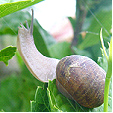
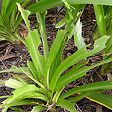
Appearance and Distribution of the Pest
Slugs and snails occur world-wide. Slugs tend to be more prevalent in heavier soil types.
Life Cycle
These insects have a Hemimetabolous life cycle, ie. When the immature nymphs resemble the adults.
Snail eggs are laid in moist soil, 20-40mm deep; eggs are white, spherical and appear in clusters of 30-100. Under favourable conditions, eggs hatch in 2-3 weeks. Newly emerged snails resemble tiny adults. When the weather is cold and dry, snails seal themselves into their shells where they survive, dormant, for 1-3 years.
Period of Activity
More active during the warmer months, although some species may remain active throughout the year.
Damage Caused
Native Australian slugs and snails are not commercial pests. Introduced species chew holes in foliage or skeletonise leaves; some plants may be completely defoliated plants; tubers and seedlings may be completely eaten. Slugs and snails feed mainly at night, especially after rain or watering; they shelter in cool, moist locations during the day. When the weather is dry, snails seal themselves into their shells with a mucous membrane, where they survive, dormant, for 1-3 years. Some species may consume up to one third of their body weight each day.
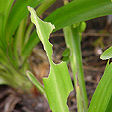
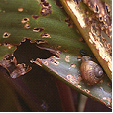
Susceptible Plants
A wide range of leafy plants, including ground crops, potatoes, tubers, leafy vegetables and seedlings.
Fern species are attacked causing serious damage. New fronds are repetitively eaten causing the plant to become stunted. Attacks are normally more severe during wet periods during which time control measures should be taken.
Morinda citrifolia is attacked by the Giant African Snail (Achatina fulica) which defoliates trees.
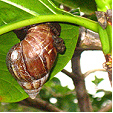

Cultural Control
Remove possible hiding places and avoid overhead watering to reduce humidity. Cultivate soil regularly; in commercial situations, allow the soil to remain fallow for one season to reduce numbers. Domestic infestations may be removed by hand. Traps may be created by inverting small pots near where snails and slugs are feeding; they will gather in these shelters during the day, and may be collected and destroyed. The popular Australian "beer trap" consists of a vertically-sided container, sunk into the ground and filled with beer, which intoxicates and drowns the snails.
Biological Control
Natural predators such as birds, frogs, and lizards reduce numbers, but do not provide effective control. Orchardists have used running ducks to control snails with some success.
Chemical Control
Commercial baits - molluscicides - made from methiocarb or metaldehyde are effective when used in combination with sanitation. Their effectiveness varies according to soil and weather conditions; it is generally recommended to avoid watering after application.
Note
Always read the label for registration details and direction of use prior to application of any chemicals.
PEST
NAME
Two-spotted Mite, Red Spider Mite
Tetranychus urticae
ORDER
Acarina
FAMILY
Tetranychidae
Description of the Pest
Also known as the red spider mite. Females are pale green or yellowish, depending on the host plant, and have two dark lateral markings; the mite becomes red in winter, retaining their dark markings. Nymphs are six-legged, with another pair of legs appearing as the mite matures. Males are smaller and narrower. Fully-grown adults are just visible to the naked eye. Two-spotted mites spread by crawling between nearby plants or movement of dead leaves.
Appearance and Distribution of the Pest
Found world-wide; an introduced pest in Australia. They congregate in protected places, such as under bark and at the base of trees, during winter. During spring, they become green in colour, and migrate back into the leaves. During heavy infestations, the leaves may be covered in visible webs, which they spin as they feed. Leaves may eventually wither and fall. Mites can spread via the movement of dead leaves, or in webs that have become attached to birds or large insects. They initially appear on the undersides of leaves.
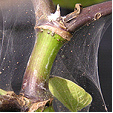
Spruce Spider Mite (Oligonychus ununguis) is a tiny greenish black adult which lays eggs on twigs where they overwinter. The pale green young spiders suck the sap turning the leaves yellow to brown. Heavy infestations form webbing and the pest is found on Abies and Juniperus species.
Banana spider mite (Tetranychus lambi) is a major widespread pest of bananas. It differs from two spotted mite by not producing copious amount of webbing. It is highly active during the dry spring to summer period and with the onset of the wet season mite numbers are reduced. The warm dry conditions that are created under plastic bunch covers is ideal for building up banana spider mite numbers.
Damage is normally confined to the underside of leaves appearing as rusty patches that coalesce along the leaf veins eventually turning the whole leaf brown-grey before it collapses. Fruit is damaged, close to the bunch stalk causing the area to become dull red purple-black, which in turn becomes dry then cracks.
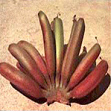 Damage fruit
Damage fruit
Control methods include careful water management during dry periods, and the reduction of dust from roadways. Regular desuckering and leaf trimming of plants will assist with a good coverage when spraying miticides.
Life Cycle
Mites have a gradual metamorphosis, with several nymphal stages. Each female lays up to 100 eggs that hatch in 7-14 days, with several generations appearing throughout the year. Females may become inactive during cold weather.
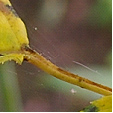 Webbing
Webbing 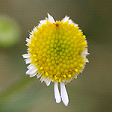
Period of Activity
The Two-spotted mite is most active in hot dry conditions. Under optimum conditions, the population can double every four days. It produces large quantities of webbing for over-wintering nests. Many plants are only susceptible to this insect when cultivated under glass.
Damage Caused
Adults and nymphs lacerated the undersides of the leaves with there rasping mouth parts, although infestations on both surfaces are not uncommon. Infestations cause leaf mottling leaf fall; premature leaf loss causes loss of vigour and reduces the quality and quantity of future crops. Repeated infestations, year after year, may weaken root growth and kill herbaceous plants.
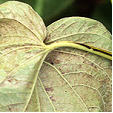
Susceptible Plants
A wide range of plants are attacked by the Red Spider Mite including annuals, fruit trees and vegetables, ornamental shrubs and trees.
Note
Many plant species are more susceptible to Red Spider Mite when they are cultivated under glass.
Other species of mite that are mentioned below have simular characteristics.
Calluna, Rose, Tropaeolum and Viola and species are infested with the Red Spider Mite (Tetranychus telarius) commonly in greenhouse situations.
Musa species are attacked by two spotted mite and banana spider mite damaging foliage and fruit.
Juglans species can be infested with up to four types of mites including red spider.
Cultural Control
Heavy rain or irrigation can reduce numbers; some plants may benefit from replanting in cooler locations. Generally, however, infested material should be completely removed and destroyed.
Preventative measures such as removing weeds or mulching around trees or shrubs or scrubbing the loose bark of susceptible trees during winter helps reduce numbers. During spring sticky bands can be wrapped around trunks close to the ground to trap the mites.
Biological Control
Natural predators include lacewings, ladybirds and thrips help keep the numbers down. Insecticide-resistant predatory mites (Typhlodromus occidenyalis) are also available commercially to control the Two-spotted Mite only on a large scale, as they require ample mites to survive.
Chemical Control
Spraying should be carried out as a last resort as many predators are killed during the operation and spraying can have the opposite effect by increasing numbers in the long term. Dimethoate will reduce numbers; however, Two-spotted mites are resistant to insecticides in some areas. Dusting with wettable sulphur may also prove effective.
Note
Always read the label for registration details and direction of use prior to application of any chemicals.
PEST
NAME
Japanese Beetle
Popillia japonica
ORDER
Coleoptera
Description of the Pest
The adult beetle has an iridescent bluish-green body with streaked grey, wing cases and is up to 12mm long. The eggs are laid in lawn or grassy areas where the small larva feed. Both adult and larva have chewing mouth parts. The insect originated in Japan and was introduced into eastern USA and southern Canada.
This insect has a Holometabolous life cycle, ie. When metamorphosis is observed during the pupal stage.
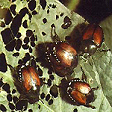
Image by Ohio State University
Period of Activity
The adult is active and the eggs are laid from summer to autumn although the female adult normally lays its eggs in the first seven to ten days of its life.
Life Cycle
The tiny white eggs are up to 1.5mm long and are deposited on the soil where they can absorb moisture. After hatching the whitish larvae are a typical curl grub and identified by a serious of bristles in a 'V' shape on its raster. There are three larva stages with the mature larvae growing to 32mm long, then pupate in the soil. The pupa is cream at first becoming red-brown and growing to 14mm long. Adults are oval shape, metallic green 10mm long by 7mm wide with brownish wing covers and five tufts of whitish hairs on either side of the abdomen.
Adult beetles emerge in early summer and find a suitable host plant to feed on, and then release an odour that attracts other emerging beetles to that plant. The females attract the males by emitting a pheromone and matting can occur on the host plant or on the ground. Fertilised females burrow into the soil up to 100mm to deposit up to five eggs then returning to the host plant and mate again. During the summer period the female deposits up to 60 eggs and under hot conditions the eggs can hatch within nine days. Under cooler conditions it can take up to thirty days for the eggs to hatch. Emerging larvae feed on the roots of the host plant.
Damage Caused
The adults skeletonize leaves and chew on buds or flowers, sometimes completely defoliating the host plant. The skeletonised leaves soon wither and die. Turf grass becomes spongy under foot as a result of tunnelling and the grass has a withered appearance in irregular patches that will not respond to watering. On inspection by lifting the turf numerous larvae can be found feeding on the roots.
Susceptible Plants
There are many broad leafed plant species that are attacked including fruit, vegetables and ornamental plants. Roses are badly affected and may have up to 50 adults on a single bloom.
The larvae attack the roots of Turf Grass such as Poa pratensis (Kentucky Bluegrass), Lolium perenne (Perennial Ryegrass), Festuca arundinacea (Tall Fescue) and Agrostis palustris (Bent).
Many trees are particularly susceptible to attack and should not be planted around turfed areas such as golf courses. These include; Acer palmatum (Japanese Maple), Acer platanoides (Norway Maple), Quercus palustris (Pin Oak), Aesculus species (Horse Chestnut), Hibiscus syriacus (Rose of Sharon), Platanus occidentalis (American Sycamore), Prunus cerasifera (Cherry Plum), Prunus x blireana (Blireana Plum), Prunus campanulate (Taiwan Cherry), Prunus x yedoensis (Tokyo Cherry), Rosa species, (Rose), Salix species (Willow), Tilia species (Linden) Ulmus species (Elms) and Parthenocissus quinquefolia (Virginia Creeper).
Vitis, Alcea, Zinnia, Hibiscus and Dahlia species are also attacked.
Cultural Control
It is difficult to control infestations of Japanese Beetles, but certain measures such as keeping soil dry during the first larval stage or avoid planting trees that are susceptible to beetle attack around lawn areas will help. Small infestations may be removed by hand during the early morning and small crops may be covered in netting for protection.
Biological Control
There is no effective natural control, but certain species of parasitic wasps help control. Soils may be infected by Bacterial Milk Disease which after a couple of years can be efficient in controlling larvae, but infected areas should not be sprayed during this period as this may kill off the bacterium.
Chemical Control
Smaller plants may be sprayed with a contact insecticide when the insect is first seen or turf areas can be sprayed with a systemic chemical.
Note
Always read the label for registration details and direction of use prior to application of any chemicals.
Note: Plants affected by this pest are Deer Resistant plants not the susceptible plants.
PEST
NAME
Deer
Cervus species
ORDER
Artiodactyla
FAMILY
Cervidae

Description of the Pest
There are two species of the deer in North America, the Whitetail (Odocoileus virginianus) and the Mule deer (Odocoileus hemionus) with several regional variations such as the Pacific coastal Blacktail (O.h. columbianus) which is regarded as a sub-species of the Mule deer.
The Whitetail on average grows to 112 cm (44in) tall and 180 mm (70 in) long and weigh 68 kgs (150lbs). The fir colour varies according to its environment but generally it is reddish-brown during summer and grey-brown in winter with a pure white underside on its tail. When the tail is erect it is known as the "white flag". Its antlers consist of two main beams from which the points emerge.
The Mule deer grow to 105 cm (42 in) tall and are up to 200 cm (80 in) long with the adult buck weighing up to 137 kgs (300 lbs) and the does up to 80 kgs (175 lbs). The fir is generally tawny brown during summer and during winter it has a heaver grey-brown to blue-grey coat with a small white tail that is tipped in black. The other distinguishing features are its ears that are up to 300 mm (1 ft) long (mule-like) and its antlers, with the two beams that are forked into smaller beams, which inturn fork again and again.
The Blacktail deer (Pacific coastal Blacktail) grows to 97 cm (38 in) tall and is up to 105 cm (60 in) long and weighs on average 73 kgs (160 lbs). The fir is generally tawny brown during summer and during winter it has a heaver grey-brown to blue-grey coat with a tail that is dark brown at the base then changing to black for 50% of its length. The antlers consist of two beams that are forked into smaller beams, which inturn fork again and again.
Appearance and Distribution of the Pest
The Whitetail deer are found throughout eastern United States, on the coast and inland but are not commonly seen in California, Utah or Nevada. They do not migrate but congregate together (yard up) during winter and feed in a part of their existing territory.
The Mule Deer are found in the western part of North America from South eastern Alaska to Mexico and from the Pacific coast to Texas. They migrate from highland mountain meadows to southern or lower snow free forested valleys during winter.
The Blacktail deer are found on the Pacific coast from Alaska to northern California. There is both resident and migratory Blacktails. The migratory Blacktails move southwards during late autumn at the first sigh of snow or heavy sustained rain and the resident Blacktails seek cover their existing territory amongst woodlands during the winter months.
Life Cycle
All Deer breed from autumn to early winter and the does give birth from late spring to early summer.
Period of Activity
Deer are most active from spring to autumn but can be troublesome during winter when the feed is scarce. In some regions urban landscapes become the major food source both in summer and winter.
Damage Caused
Browsing deer will feed on almost any plant and is most commonly noticeable during spring feeding on the new growth or twigs and stems leaving a shredded appearance. Deer also rub their antlers against trees damaging bark and snapping off small branches, this action also incurs damage under hoof as plants, lawns and garden structures are trampled on.
Susceptible Plants
Some plants are more palatable to deer but when a deer is hungry or during drought conditions there are no "Deer Proof" plants. There is a range of plants that have a bad taste and are not destroyed and are regarded as (deer resistant plants). Deer resistant plants are the plants that are attached to this file not the susceptible plants.
Cultural Control
There are many cultural controls that have been tried to move browsing deer such as frightening them with strobe lights, pyrotechnics or tethered savage dogs. These actions are only temporary and may cause more trouble as the stampeding animals move off. Fencing and netting can be an effective method of discouraging hungry deer from gardens but may be expensive on a large scale and require maintenance. There are several types of fences which include conventional 2.2m (8 ft) deer-proof woven wire fences or single-wire electric fences and slanted deer fences. Plant selection can also be effective, by using less desirable plants (deer resistant plants) as an outer border to the more desirable plant species and thus discouraging the deer to enter the garden. Hedges and windrows of less desirable thorny plants can also be a deterrent to browsing deer.
Chemical Control
There are two main types of repellents contact and area. Contact repellents are applied directly to the plants and deter deer with a bad taste or smell. They can be applied by rubbing or spraying on to the plants and commonly used in an egg mixture. The commercial products have proven to work better than home remedies which include soap or chilli mixtures and hanging bags of human hair.
Area repellents rely on an offensive odour and are placed around areas that are frequently visited.
Contact your local distributor for available types and application.
Note: Plants affected by this pest are the Rabbit Resistant plants not the susceptible plants.
PEST
NAME
Rabbits
Oryctolagus cuniculus & Sylvilagus species
ORDER
Lagomorpha
FAMILY
Leporidae

Description of the Pest
There are a eight different genera in the family classified as rabbits and include the European Rabbit (Oryctolagus cuniculus) which has infested Australia and the Cottontail rabbit (Sylvilagus spp.) which consists of 13-species with 9-species found in North America.
Generally rabbits have an egg-shaped body that can range in size from 200 mm to 500 mm long and weigh up to 2 kg. They have long ears that are adapted for detecting predators and powerful large hind legs allowing them to move fast. The body is covered in buffed, long soft fur that is brown or grey and the mouth has two sets of incisor teeth which are located one behind the other.
The cottontail rabbit grows up to 450 mm (18 in) tall and weighs 1.36 kg (3 lbs).
Appearance and Distribution of the Pest
Generally rabbits live in a variety of habitats including meadows, woodlands, forests, grasslands or deserts and wetlands living in groups with some underground in borrowers. The European Rabbit has been introduced to many parts of the world and in 1859 Thomas Austin brought 24 breeding pairs to Australia which subsequently escaped and quickly bred throughout Victoria and New South Wales and by the 1900's the rabbits had reached the Northern Territory and Western Australia.
Life Cycle
The life span varies with each species. Cottontails for example can live for one year to a maximum of three years in the wild but in captivity they can last for eight years, during which time they can raise between 2-6 litters per year and produce up to 18 kittens during the breeding season. In the cooler northern parts of North America the size and number of litters are generally smaller only 2-3 but in southern regions such as Mexico or Australia, European rabbits can produce 5-6 litters per year, normally commencing during spring time and continuing throughout the year. Each litter can consist of 2-8 or more kittens. Under ideal seasonal conditions a mature doe (female) can mate again several hours after giving birth and has a gestation period from 28-30 days.
Period of Activity
Generally rabbits eat throughout the year but in cooler countries such as North America they are more active during the spring to summer period but in warmer climates such as Australia rabbits can cause significant damage throughout the year.
Damage Caused
in Australia the effects of rabbits on the landscape has been a devastating resulting in the loss of an unknown number of plant species and a ring barking of young trees in orchards or forests. Major erosion problems have also resulted from warrens or plant denuded landscapes which are left vulnerable to the elements.
A rabbits generally will eat most flowers or the bark of woody plants, grasses of all types and most agricultural crops (vegetables).
Susceptible Plants
Rabbits mainly consumed grasses or garden vegetables and a broad range of ornamental plants. In cool climates where snowfalls rabbits eat twigs, bark and buds from the dormant plants. When rabbits are hungry they will eat most plants but attached to this file are rabbit resistant plants that are less palatable. Their resistance will vary depending on the stage of growth as new shoots are very desirable to rabbits.
Cultural Control
Control methods include trapping, hunting and exclusion with the use of fences, all of which had a marginal success. Many predators utilise rabbits as a food source for example foxes, feral dogs and cats, hawks or owls and human hunters.
Biological Control
In Australia to biological diseases have had reasonable success. In 1950 Myxomatosis was released into the rabbit population and resulted in the numbers dropping from 600 million to 100 million. Remaining populations became immune and steadily increased numbers to 300 million by the 1990s. The calicivirus was accidentally released in 1996 and culled populations significantly in regions of extreme heat but was less effective in cooler regions where the rabbits were exposed to a lesser calicivirus that immune them.
Chemical Control
Baiting and chemical repellents programs relied on the territorial habits of rabbits as they rarely forage further afield from their territorial areas.
Note
Landholders should seek advice from their local government agencies. This advice will include fumigation or destruction of warrens, fencing and shooting.
DISEASE
NAME
Bacterial Rot
Various Bacterial Species
Description
Bacterial problem associated with water soaked strips on the leaves, stem, roots, fruit or flower. Bacterial wilts produce causative slime that clogs the water-conductive tissue of a plant.
Symptoms
Bacterial Blight (Pseudomonas mori) forms water soaked spots on the leaves and shoots, becoming sunken and turning black causing the leaves and twigs to wilt and die.
There is also a Bacterial Blight (Pseudomonas syringae pv pisi) that infects legumes during humid weather with water soaked spots on the leaves and stems near the base. The spots become dark and as the stem shrivels, yellow lesions appear. Leaves and fruit pods turn brown and die.
Bacterial Leaf Spot (Pseudomonas viburni) forms wet spots that enlarge becoming brown and sunken. These spots can be seen on the leaves and young stems and the bacteria overwinter in buds or in cankers. It is found on Viburnum species.
Bacterial Wilt (Xanthomonas species) infects palms causing the lower fronds to wilt then turn grey-brown and die. This is followed by the crown becoming spongy (rotted) attacking the vascular tissues and eventually causing the collapse of the crown. There is also a Bacterial Leaf Spot (Xanthomonas species) that causes spots on leaves with water-soaked margins and is found on Alocasia species.
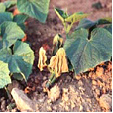 Bacterial Wilt
Bacterial Wilt
Bacterial Wilt (Pseudomonas solancearum biovar 1 and 3). This disease initially turns the youngest leaves pail-green to yellow; they then wilt turn brown and die. It eventually affects the entire plant and is found on Heliconia species.
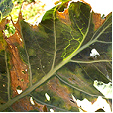
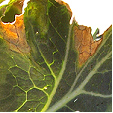 Black Rot or Bacterial Wilt
Black Rot or Bacterial Wilt
Black Rot or Bacterial Wilt (Xanthomonas campestris) is a bacteria rot that infects the leaves and seedlings of Cruciferous vegetables causing 'V' shaped pale yellow blotches to appear, normally infection occurs along the margin of the leaf or through damaged areas of the leaf. It also causes the flower head to become stunted and the veins or water conducting tubes in the leaves and stems to turn brown or blackish. Heavy infections cause the plant to wilt and die.
Bud Rot (Xanthomonas cannae) infects young leaves and flower buds of Canna species, killing them. Small whitish spots appear as the leaves or buds open, these enlarge then run together turning black. The symptoms also extend to the petioles and stems forming yellowish water soaked areas and the bacterium overwinters in the rhizomes.
Halo Blight of Beans (Pseudomonas syringae pv phaseolicola) forms water soaked or greasy angular spots on the pods or stems of the host. This causes the plants to yellow and become stunted. During humid weather a white slime is exuded from the damaged areas.
Soft Rot (Pecotbacterium carotovorum) affects bulbs, initially stops flowers from blooming or forming correctly. These flowers are shed, and the plant rots at the base causing it to collapse. On inspection of the bulbs a white foul smelling viscous smell is associated with a soft rot.
Wetwood (Erwinia nimipressuralis) causes wilting and branch dieback in Ulmus species. The wood forms dark water soaked areas with no obvious streaking in the outer sapwood.
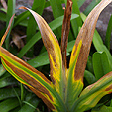 Yellow Rot in Iris
Yellow Rot in Iris
Yellow Rot (Xanthomonas hyacinthi) is a bacterial disease infects the cell walls of the leaf, stem and bulbs and caused yellowish water soaked areas to appear. These areas become brown and shrivel, or pockets of rot appear, soon engulfing the entire bulb. The disease may start from the leaf down or from the bulb up infecting the whole plant. A cross section reveals vascular tissue that is choked with yellowish slime. Infected plants soon brown off, collapse and die.
Source and Dispersal
The bacterium is found in infected plant material and not necessarily the soil and is spread by splashing water, wind or infected stock.
Favoured Conditions
It prefers warm moist conditions normally during spring.
Affected Plants
These bacteria attack many plants including; onions, Hyacinth species and its varieties, this can be a major problem in bulb nurseries.
Vegetables such as potatoes are also infected by blight which forms dark brownish spots on the leaves that become larger, eventually killing them and followed by lesions on the stems. The roots are infected by falling spores and peas suffer from a bacterial blight that forms spongy leaves with dark brown edges. The leaves and stem shrivel and die.
 Strelitzia nicolai
Strelitzia nicolai
Archontophoenix and Strelitzia species are susceptible to the Bacterial Wilt (Pseudomonas solanacearum). The leaves become yellowish and brownish along the margins causes the fronds to wilt and dry out. The vascular tissue in the stems then becomes blackish and the plant dies prematurely.
Berberis species are infected by the Bacterial Leaf Spot (Pseudomonas berberidis) forming irregular dark green water soaked areas that turn purplish brown. It also infects young shoots and petioles or damaged areas.
Bougainvillea and Limonium species are infected by the Bacterial Leaf Spot (Pseudomonas andropogonis) which forms orange angular spots that are lighter in the centre and cause the leaves to fall prematurely. It is most common in tropical regions.
Caryota mitis (Clumping Fish Tail Palm) is infected by the Bacterial Blight (Pseudomonas avenea). The symptoms include water soaked translucent areas along the leaf veins that mature to brown then black with a chlorotic halo that is up to 2 mm wide by 50 mm long. Leaves of all ages are infected and immature leaves are more severely infected.
Control methods include eliminating overhead watering, removing infected foliage and improve air circulation around the plant.
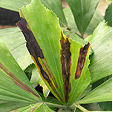 Caryota mitis
Caryota mitis
Cheiranthus species and other plants in the Brassicaceae family are infected by the Bacterial Wilt (Xanthomonas campertris) causing the leaves to wilt, turn yellow and die. It also stunts the inflorescence and turns the phloem and xylem blackish. Other plants that are infected include, Arabis, Armoracia, Aubrieta, Brassica, Hesperis, Iberis, Lobularia and Mathiola species.
Corylus species are infected by Blight ((Xanthomonas corylina) that attacks the leaves and branches.
Delphinium species are infected by several leaf spots including the bacterial disease Black Leaf Spot (Pseudomonas delphinii) which produces irregular tar-like spots on the upper surface of the leaf with corresponding brownish areas on the underside. This infection may extent down the petiole to the twigs. It normally occurs during cool weather affecting the lower leaves first.
Dianthus species are infected by the Bacterial Wilt (Pseudomonas caryophylli) which turns the leaves greyish, then yellowish before dieing. Yellowish streaks are also seen on the stems.
Dieffenbachia species are infected by two Bacterial Leaf Spots (Erwinia species) and (Xanthomonas campestris pv. dieffenbachiae). Both form yellowish spots that turn brown on the leaves that have water-soaked margins.
Eschscholtzia species are infected bt the Bacterial Blight (Xanthomonas papavericola) which forms tiny black spots that are water soaked and may be ringed.
Euphorbia pulcherrima is infected by Bacterial Canker (Corynebacterium poinsettiae) which forms streaks on the green stems that are water-soaked. The leaves may also be affected producing spots or blotches.
Gladiolus, Crocus and Freesia species are susceptible to Bacterial Scab (Pseudomonas marginata). This disease attacks the corms by forming slightly raised yellowish lesions that develops a raised rim with a soft sunken centre, producing bacterial exudate. It also infects the leaves with small reddish spots appearing towards the lower part. These spots merge and destroy the basic cell structure (parenchyma tissue) in the petioles causing the leaves to fold downwards, eventually killing the plant.
Hedera helix is susceptible to the Bacterial Leaf Spot or Stem Canker (Xanthomonas hederae). This infection commences with pale green water soaked spots or areas appearing on the leaves. These areas than become brown-black and dry with reddish margins, eventually engulfing the leaf causing it to shrivel. The bacterium then extends along the twigs and into the stems causing cankers. Several Fungal leaf spots develop simular symptoms and may be difficult to distinguish the difference. Generally avoid high humid temperatures and water plants at the base.
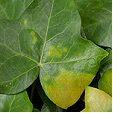
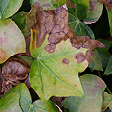
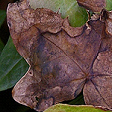 Hedera helix
Hedera helix
Morus species are infected by Bacterial Blight (Pseudomonas mori).
Orchids such as Cattleya, Cymbidium, Cypripedium, Dendrobium, Epidendrum, Oncidium, Paphiopedilum, Phalaenopsis and Zygopetalum species are infected by Bacterial Brown Rot (Pseudomonas cattleya) which forms water-soaked leaf spots that turn brown. Phalaenopsis species are particularly susceptible.
Caryota species are susceptible to Bacterial Leaf Blight (Pseudomonas albopercipitans). This disease forms elongated water soaked areas on the fronds that are translucent at first becoming blackish.
Roystonea regia, Cocos nucifera and Phaseolus species are infected by Bacterial Wilt (Xanthomonas species).
Tropaeolum species are infected by Bacterial Leaf Spot (Pseudomonas aptata) forming spots and rotting the leaves. They are also infected by the Bacterial Wilt (Pseudomonas solanacearum) which gains access through damaged roots or through the stomates, causing yellowing, wilting and the death of the plant.
Zinnia species are attacked by Bacterial Wilt (Pseudomonas solanacearum).
Non-chemical Control
Remove and destroy any infected plants. As a preventive measure cultivate the surrounding soil to improve drainage, aeration and minimise weed growth. Do not over water and allow the soil surface to dry before rewatering. When handling the plants pick a dry period and take care to minimise damage.
At first sigh of infection the plant should be removed and disposed off and avoid replanting susceptible vegetables such as peas for up to three years.
Chemical Control
There is no satisfactory chemical control. It is important to take preventive measures.
Note
Always read the label for registration details and direction of use prior to application of any chemicals.
DISEASE
NAME
Powdery Mildew
Various Powdery Mildew Species
Description
Powdery mildew covers arrange of fungal infections most with simular characteristics of white powdery areas appearing on the leaves and flowers.
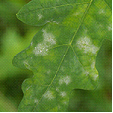
 White powdery area
White powdery area 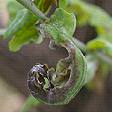
Symptoms
Powdery mildew (Oidium species) affects the following five plant groups with slightly different characteristics.
Cucurbits firstly form white spots on the underside of the leaves. Under optimum conditions the fungus spreads to the upper surface covering the entire leaf causing it to die. It may also extend to the stems slowing the growth of the plant and may reduce the size of the fruit.
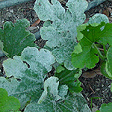
Grape leaves, flowers and fruit are attacked with the appearance of greyish-white powdery spots. Infected flowers set poor quality fruit and infected fruit splits open and dries out.
Pawpaw leaves become infected on the underside at first then spreading covering the entire leaf. The fruit forms irregular light grey spotted areas that damages the surface and under the surface causing the fruit to misshapen and reducing its market value.
Rose leaf and buds are covered in a fine white powdery coating and in severe cases it extends to the stems. When young leaves are infected they become distorted and older leaves develop blackened areas. Infected flower buds may fail to open and opened blooms may be discoloured or distorted.
Strawberries show different signs of infection with the leaf margins first rolling upwards then developing purplish irregular blotches along the veins. The infected flowers may fail to set fruit and if fruit is produced it is small, hard fails to ripen. Semi mature fruit that is infected has dull appearance and may form cracks or split open.
The Powdery Mildew (Sphaerotheca lanestris) infects leaves and twigs. The under side if the leaf firstly has a white mealy growth that matures to felt-like brown mycelium that can cover the entire leaf, and the twig tips. It is only one of the many types that infect Quercus species.
Source and Dispersal
The spores overwinter in fallen leaves, dormant buds, seed and infested plants. It is dispersed by wind.
Favoured Conditions
Generally it prefers warm humid conditions, but failing to germinate when it is raining. The fungus that attacks Pawpaw prefers cooler conditions disappearing in the warmer months.
Affected Plants
There are many plant species ornamental trees and shrubs that are attacked by Oidium species including; Roses, African Violets, Cucurbits, Grapes, Pawpaw, Strawberries, Hydrangeas, Ajugas, Antirrhinum, Oaks and Photinias.
Acer species are infected by the powdery mildews (Uncinula circinata) and (Phyllactinia corylea) but are not normally serious.
Aesculus species are infected by the powdery mildew (Uncinula flexuosa) which forms a white mold on the underside of the leaves.
Arenaria,Cuphea, Erica and Eschscholtzia species are infected by the powdery mildew (Erysiphe polygoni). This fungus is greyish or white and covers leaves or young shoots. Heavenly infected leaves turn brown and fall from the plant. The plant eventually dies.
Aster species are infected with the powdery mildew (Erysiphe cichoracearum) which is more prevalent on the lower part of the plant.
Ceanothus, Corylus, Platanus, Syringa and Weigela species are infected by the powdery mildew (Microsphaera alni) particularly London Plane. The mycelium forms a felt-like cover on the leaves.
Celtis species are susceptible to the powdery mildew (Uncinula parvula) and (Uncinula polychaete). This fungal problem can affect either side of the leaf, which can have spots or be completely coved in mildew. The fruiting bodies appear on the opposite side of the mildew.
Cornus species leaves are infected by the powdery mildew (Microsphaera alni) and (Phyllactinia corylea), covering the leaves in a whitish fungus.
Dahlia species are infected by the powdery mildew (Erysiphe cichoracearum) that forms white powdery areas on the leaf surface.
Lagerstroemia species are infected by the powdery mildew (Uncinula Australiana) that forms white powdery growth on the leaves and may also distort the infected foliage.
Populus and Salix species are infected by a white powdery mildew (Uncinula salicis) that produces black fruiting bodies with a curled tip, but is not normally a major problem.
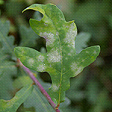
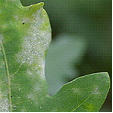 Quercus robur
Quercus robur
Quercus species are susceptible to several powdery mildew fungi including (Sphaerotheca lanestris), (Erysiph trina) and (Phyllactinia corylea). Generally white mealy growth appears on the leaves, normally on the underside turning the infected areas brown and then the leaf dies. The infection may spread to the twig tips causing dieback. Control may be difficult and unwarranted on large trees but nursery stock may be sprayed with a fungicide during susceptible periods.
Rosa species are also infected by the powdery mildew (Sphaerotheca pannosa).
Rudbeckia and Senecio species are covered in white fungus (Erysiphe cichoracearum) which infects leaves, flowers and stems. This results in the plant becoming stunted.
Senecio species are infected by the powdery mildew (Sphaerotheca fuliginea) which forms circular white powdery areas on the leaves.
Spiraea species are infected by the Powdery Mildew (Microsphaera alni) and (Podosphaera oxyacanthae).
Ulmus and Rhododendron (Azalea) species are also infected by (Microsphaera alni). Circular patches of white powdery growth appear on the leaves.
Veronica species are sometimes infected by the powdery mildew (Sphaerotheca humili) causing a white coating to appear on the leaves. Not normally a major problem.
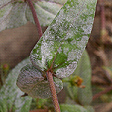
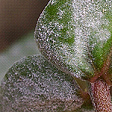
Zinnia elegans are commonly infected by the powdery mildew (Erysiphe cichororacearum), which appears on both sides of the leaves as a greyish powdery cover and may be transmitted by seed.
Non-chemical Control
Choose less susceptible species and when planting space the plants to allow good air circulation. Avoid overwatering and try to keep the foliage dry. Affected plants may be dusted with powdered sulphur or sprayed with a milk mixture to discourage mildew. Vegetables that are infected with mildew should be removed and replaced with new young plants, as they are more resistant to infection.
Chemical Control
Prenatitive spraying during warm humid conditions using a suitable fungicide such as wettable sulphur, bitertanol, carbendazim, fenarimol and triforine helps control the problem.
Note
Always read the label for registration details and direction of use prior to application of any chemicals.
DISEASE
NAME
Sclerotinia Rot, Crown Rot
Sclerotinia species
Description
A fungal problem that attacks plant parts causing them to collapse and rot, including flower, leaf and stems.
Symptoms
This fungus attacks all the above ground parts of the plant but commonly infects the stem at the base, where it forms a soft, light brown watery rot that spreads rapidly. Under humid conditions the rotted areas forms white fluffy mycelium on which black sclerotia up to 10mm long develop. These sclerotia also form within the stem in affected areas. When leaves are infected the tissue may brown and dry out, especially during arid conditions. The resulting affect of infection is the death of the plant.
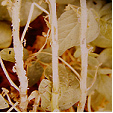
Image by B. Sonsie
Crown Rot (Sclerotium delphinii) causes leaves to turn yellow then become dry, and blossoms to wilt eventually killing the entire plant. It is found on Scilla, Viola and Delphinium species.
Flower Blight (Sclerotinia camelliae) infects flowers either by attacking the top of the petals forming brown specks or at the base of the flower where the petals turn brown then fall with out any sign of rot. The fungus develops on the fallen petals where microconidia are produced under moist conditions and eventually sclerotia appear. This form of the fungus can overwinter either above or below soil level until favourable conditions occur, then the spores are released and dispersed by wind.
Source and Dispersal
Sclerotia are found in the soil or on other infected plants and released spores are dispersed by wind.
Favoured Conditions
Prefers cool moist conditions with temperatures from 10º to 25ºC and is more common from autumn to spring when it is wet.
Affected Plants
A wide range of plants can be infected included French beans, peas, celery, cabbage, cauliflowers, carrot, parsnip, dahlia stocks, primula and many weeds.
Actinotus, Dampiera, Westringa species and Helichrysum bracteatum are infected by the Crown Rot (Sclerotinia rolfsii). Basial rot of the plant with cottony fungal growth and is associated with root congestion. Certain species of orchid may also be attacked.
Allium species are infected by the White rot (Sclerotium cepivorum) which is a major fungal disease of plants.
The bulb rot and are covered in mycelial which develop small black sclerotia (fruiting bodies) and infected plants may fail to produce flowering stem with the leaves become covered in a white mould, turning yellow then dieing off. It is commonly transmitted by infected seedlings and diseased plants should be burnt. Avoid re-planting Allium species in the infected soil where the spores overwinter. Soil may be infected for several years.
Antirrhinum, Aquilegia, Lobularia and Mathiola species are attacked by the Stem Rot (Sclerotinia sclerotiorum ) which infects the stigma travelling downwards through the flower into the stem where water soaked areas appear causing it to collapse. The flowers become pale and the entire plant may collapse. On inspection flat sclerotia may be seen in the stem.
Camellia species may be infected by Flower Blight (Sclerotinia camelliae) which causes blooms to fall and Stem Rot (Sclerotinia sclerotiorum).
Hyacinthus species can be infected by the fungus Black Slime (Sclerotinia bulborum) that causes the leaves to turn yellow then fall and bulbs to disintegrate.
Iris species are infected by the fungus Rhizome Rot (Botryotinia convoluta) that infects the rhizomes and forms black sclerotia, and is normally found on dieing plants during spring.
Turf Grass in warm climates is susceptible to Rolf's Disease (Sclerotinia rolfsii). The fungus infects the turf causing isolated dead patches up to 450mm across from spring to summer. As it progresses the dead patches increase in size and the white cotton-like mycelium can be seen in the underlying soil. It is not regarded as a major problem, with minor attacks on Cynodon dactylon (Couch) and Zoysia species.
Non-chemical Control
Initially remove and destroy any infected plants, when replanting, avoid using susceptible crops for 3 years. Space the plants to reduce the humidity and airflow and cultivate the soil to increase the drainage. Remove weed growth and leaf or flower litter from around the base of the plants to reduce the development of spores
Turf Grass culture such as aerating soil and maintaining a neutral pH helps prevent infection of Rolf's Disease.
Chemical Control
No suitable fungicides available, though drenching or spraying the soil with the fungicide dichloran helps control it.
DISEASE
NAME
Spotted Wilt Virus
Various Spotted Wilt Virus
Description
Viral problem that infects the leaves and stems of many plants.
Symptoms
Spotted Wilt Virus is a systemic disease that attacks a variety of plants with variable symptoms. In tomatoes young plants are particularly venerable, as indefinite mottling or rings first form on the upper surface of young leaves, eventually covering the leaf, causing it to shrivel and die. Stems and petioles or peduncles develop brownish streaks as the virus spreads eventually killing the young plants.
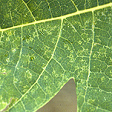 Pawpaw
Pawpaw
Older plants that are attacked produce new foliage that is mottled with bronze colouring which soon turns black causing the leaf to shrivel and die. Stems can also be affected with brown streaks and fruit of an infected plant, ripens unevenly and is marked with circular blotches. This may cause premature fruit fall.
Spotted wilt also causes plants to become stunted and for flowers to develop reddish or yellow rings.
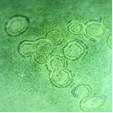 Fruit
Fruit
Source and Dispersal
The virus is found on other infected plants and is spread by thrips, particularly Onion thrips (Thrips tabaci) and Western Flower Thrips (Frankliniella schultzei). The virus may also be dispersed in infected rhizomes or tubers or nursery stock.
Favoured Conditions
Hot dry weather favours thrips activity particularly during summer, spreading the virus which appears 2 to 3 weeks later.
Affected Plants
A wide range of vegetables and ornamentals are attacked include capsicums, potatoes, broad beans and
Amaryllis, Anemone, Antirrhinum, Aster, Begonia, Calceolaria, Calendula, Chrysanthemum, Dahlia, Gerbera, Lactuca, Lathyrus, Lilium, Lycopersicon (Tomato), Nasturtium, Papaver, Pericallis, Petunia, Phlox, Schizanthus and Zinnia species.
All have simular symptoms with yellowish wavy marks that spread causing the leaf to distort turn brown and die.
Other plants such as Zephyranthes species develop yellow or parallel streaks on the leaves that spread to the stems.
Non-chemical Control
Preventative measures are important for the uninfected plants by not planting near tomato crops and the removal of weeds. The controlling of thrip infestations greatly reduces distribution of the virus.
Chemical Control
There is no chemical control of viral problems.
DISEASE
NAME
Leaf Spot (General)
Various Leaf Spot Species
Description
There is a wide variety of fungal leaf spots that infect perennials, shrub and trees. Some are specific to the host while others can affect a range of plants.
Symptoms
Generally light brown to purplish or blackish spots appear on the leaf and form concentric rings of fruiting bodies. The spots may leave holes, perforating the leaf or expand with pale green to yellowish margins and when the holes merge the leaf normally dies. There are many different types of leaf spot, some are discussed below.
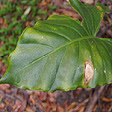 Alocasia species
Alocasia species 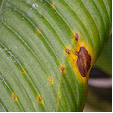
Alternaria Leaf Spot (Alternaria nelumbii) forms a small reddish brown spots that are boarded in light green, and as they develop in size the leaf curls and dies from the margin inwards. Normally occurs on Nelumbo species (water lilies).
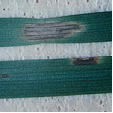 Helminthosporium Disease
Helminthosporium Disease
Helminthosporium Disease (Bipolris species), (Drechslera species) and (Exserophilum species) are responsible for several leaf spots that occur on all Turf Grass species. Generally they form black or white spots that may be faded and produce masses of spores in the thatch during late summer, under humid conditions. The life cycle is short and when conditions are favourable spores are splashed onto the foliage from the thatch, causing wide spread infection. Cynodon dactylon (common couch) is most susceptible and found in bowling or golf greens where it is a serious problem.
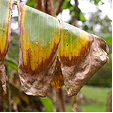 Banana Leaf Spot
Banana Leaf Spot 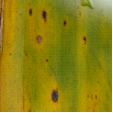
Banana Leaf Spot (Mycosphaerella musicola) is found on many species of banana causing pale yellow streaks on the young leaves to turn brown with dark spots. The leaf then becomes dried, brown and dead commencing from the margins, eventually the leaf dies. Control requires removal of infected foliage or the spraying of a fungicide and fungicides should not be used during the fruiting period.
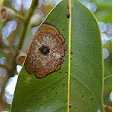
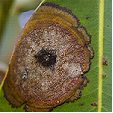 Lophostemon confertus (Brush Box)
Lophostemon confertus (Brush Box)
Leaf Spot on Brush Box (Elsinoe species). This is a casual fungus that attacks the epidermal layer of the leaf, forming circular spots that are up to 25mm across and are often restricted by the main vein. These spots are a dull yellowish brown but can also have purplish patterns. A leaf may have more than one spot develop on its surface and normally appears on scattered leaves throughout the tree. This doesn't affect the vigour of Lophostemon confertus.
Palm Leaf-scab (Graphiola phoeicis) appears as yellow spots and develop into scabs or warts that are outwards hard and dark but with a soft centre with powdery yellowish brown spores. The infected leaves eventually die.
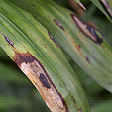 Palm Leaf Spot, Chamaedorea elegans
Palm Leaf Spot, Chamaedorea elegans
Palm Leaf Spot (Pestaloptiopsis species) appears as a small spot with a dark centre on the leaves and affects palms that are growing in shaded humid positions and normally control is not required, though infected fronds should be removed.
Source and Dispersal
Infection source is other contaminated plants and the spores are spread by wind or by splashing water. The fruiting bodies are black spots that appear on the damaged tissue releasing spores.
Favoured Conditions
This fungus prefers a warm humid environment and leafy plants with soft new growth, particularly if they are crowded.
Affected Plants
There are many ornamental and native plants that are hosts to a wide range of fungal leaf spots. Some specific ones are listed below. Plants such as Cornus or Paeonia species are infected by a large variety of leaf spots, while other plants attract a specific leaf spot.
Generally a healthy plant can tolerate fungal leaf spot attack, though it may make the plant look unsightly. In trees and shrubs it is difficult to control and generally not necessary, but in perennials and annuals control may be necessary in order to save the plant.
Acalypha and Arctotis species are infected by up to three leaf spots including (Cercospora acalyphae) and (Ramularia acalyphae) that rarely require control.
Acer species are infected by Purple Eye (Phyllosticta minima) which forms spots with brownish centres and purplish margins causing the death of the leaves.
Acer species are also infected by Tar Spot (Rhytisma acerinum) which forms round black spots that have yellow margins. Not normally seen on cultivated trees, but seen in forests.
Adiantum, Asplenium, Blechnum, Cyathea, Davallia, Nephrolepis, Platycerium, Polypodium and Pteris species are infected by the leaf spot (Pseudocercopora species) which forms circular brown spots on the fronds and heavy infection can defoliate a plant.
Aesculus species are occasionally infected with the leaf spot (Septoria hippocastani) which forms small brown spots.
Agave species are susceptible to the leaf spot (Coniothyrium concentricum), which appear as greyish spots up to 20mm (1in) across with concentric rings and black fruiting bodies. Affected leaves are destroyed as the infection spreads.
Albizia julibrissin is susceptible to the fungal leaf spot (gloeosporium aletridis), which does not normally require control.
Amelanchler, Chaenomeles, Crataegus and Rhaphiolepis species Mespilus germanica are infected by the leaf spot (Fabraea maculata) which may cause considerable damage during wet periods.
Aquilegia species can be infected by three types of Leaf Spot including (Ascochyta aquilegiae), (Cercospora aquilegiae) and (Septoria aquilegiae), normally appearing during humid conditions forming spots on the leaves.
Arbutus species are infected by two leaf spots (Septoria Unedonis) which produces small brown spots on the leaves and (Elsinoe mattirolianum).
Arctostaphylos manzanita is infected by the leave spot (Cryptostictis arbuti) which damages leaves but is not normally detrimental to the shrub.
Aspidistra species are infected by the leaf spot (Colletotrichum omnivorum) causing whitish spots on the leaves and petiole.
Aster species are infected by many leaf spots including (Alternaria species), (Cercosporella cana), ( Ovularia asteris) and (Septoria asteris).
Aucuba species are infected by several leaf spots, usually as a secondary infection after aphid attack. These include (Phyllosticta aucubae) and (Phyllostica aucubae).
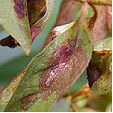
 Azalea
Azalea
Azalea (Rhododendron species) are susceptible to Leaf Scorch (Septoria azalea). This fungal disease forms reddish- brown spots which expand and engulf the leaf, with fruiting bodies appearing in the centre. Infected leaves die, then fall and the branchlets wilt. This problem is more serious during wet periods and may require control using a fungicide.
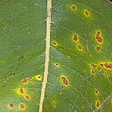 Banksia robur
Banksia robur
Banksia species are infected by several leaf spots causing chlorotic areas that have brown centres and is not normally a major problem for the plant.
Betula species may be infected by the Leaf Spots (Gloeosporium betularum) that forms brown spots with darker margins and (Cylindrosporium betulae) that also forms brown spots with faded indefinite margins.
Bougainvillea species are infected by the leaf spot (Cercosporidium bougainvilleae) which forms rounded spots with dark margins that yellowish ting. Infected leaves die and fall from the plant.
Calendula species are infected by the Leaf Spot (Cercospora calendulae) which rapidly infects the plant spotting the leaves and killing the plant.
Callicarpa species may be infected by the leaf spot (Atractilina callicarpae) forming irregular brownish spot or (Cercospora callicarpae) which can defoliate the plant in subtropical climates.
Campsis species may be infected by several fungal leaf spots including (Phyllosticta tecomae), (Septoria tecomae) and (Cercospora duplicata).
Carpinus species are infected by the leaf spots (Gloeosporium robergei), (Gnomoniella fimbriata) and (Septoria carpinea), all are minor infections not normally requiring control.
Carya species are infected by several leaf spots including (Gnomonia caryae) that infects leaves with irregular reddish spots on the upper surface with corresponding brown spore producing spots on the underside. It also has a secondary spore release that occurs on the dead leaves where it over winters. Other leaf spots include (monochaetia desmazierii) and (Marssonina juglandis).
Ceanothus species are susceptible to the leaf spot (Cercospora ceanothi) and (Phyllosticta ceanothi) both are of minor importance not requiring control.
Celtis species are infected by many leaf spots including (Cercosporella celtidis), (Cylindrosporium celtidis), (Phleospora celtidis) and (Septogloeum celtidis).
Chrysanthemums species are infected by the leaf spot (Septoria species) which forms yellow spots appear toward the edge of the leaves; these become enlarged brownish patches with yellow margins. Damaged areas may converge and in severe attacks and the leaves may fall prematurely or flower production is reduced.
Clematis species are infected by the fungal disease (Ascochyta clematidina) which may cause stem rot or leaf spots that are water soaked areas with reddish margins. The infection spreads from the leaves to the stem causing wilting and eventually girdling the stem killing the plant. There are many fungal leaf spots that infect this plant including (Cercospora rubigo) and (Septoria clematidis)
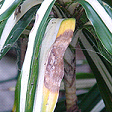 Dracaena deremensis
Dracaena deremensis
Cordyline and Dracaena species may be infected by the leaf spot (Phyllosticta maculicola) which forms small brownish spots that have yellowish margins and has black fruiting bodies that forms coils of spores. These plants are also susceptible to other leaf spots such as (Glomerella cincta) and (Phyllosticta dracaaaenae). Keep foliage dry to avoid infection.
Cynodon dactylon, Pennisetum clandestinum and many other Turf Grasses are susceptible to Helminthosporium Disease.
Daphne species are infected by the leaf spot (Gloeosporium mezerei) and (Marssonina daphnes) both of which form thickish brown spots that are seen on both sides of the leaves. Infected leaves turn yellowish before dieing.
Dendranthema species are infected by many leaf spots such as (Septoria chrysanthemi) which first forms yellowish spots up to 25mm (1in) across that become black. Infected leaves die prematurely and persist on the plant.
Dianthus species may be infected by the leaf spot (Septoria dianthi). It forms light brown rounded spots that have a purplish border. The scattered spots on the lower leaves can also be found on the stems and the spores are dispersed by water from the tiny black fruiting bodies.
Dieffenbachia species are infected by several leaf spot fungi including (Cephalosporium species) and (Myrothecium species).
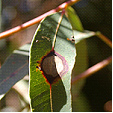 Eucalyptus species
Eucalyptus species
Eucalyptus species are infected by many fungal leaf spots such as (Mycosphaeralla species), (Hendersonia species) and (Monocheatia monochaeta). Generally leaf spots appear on the juvenile or new leaves causing brownish spots that enlarge and may have a purplish halo around the margin. Mature adult leaves are not normally infected and the trees rarely require control measures.
Fern species are infected by the leaf spot, (Alternaria polypodii). This fungus appears as brown circular or oblong spots that congregate along the margins of the pinnae causing the fronds to turn brown and die. It is spread by wind currents from plant to plant and control methods include removing infected fronds and maintaining a drier atmosphere.
Ficus species are infected by various fungal leaf spot including (Pseudocercospora species). Generally the fungal attack forms circular or irregular dark coloured spots on the leaves eventually causing them to fall prematurely.
Ficus elastica is susceptible to many fungal leaf spots including (Alternaria species), (Leptostromella elastica) and (Phyllosticta roberti).
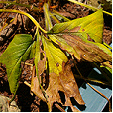
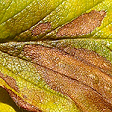 Strawberry
Strawberry
Fragaria x ananassa (Strawberry) is infected by the fungal leaf spot (Mycospharella fragariae). The mature leaf is initially infected with well defined brown spots that that turn light grey with red-purplish margins. As the spots merge they form large brown blotches and the leaf turns yellow then dies. This fungal attack normally occurs on plants in poor health and can be a serious problem early in the season seriously damaging stock.
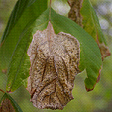 Fraxinus species
Fraxinus species
Fraxinus species are infected by the leaf spot (Gloeosporium aridum) giving the leaf a scorched appearance as large blotches appear from the margin or apex and turn brown with a papery texture. It is more prevalent during rainy periods and infected leaves fall prematurely. Collect and depose of fallen leaves otherwise control is not normally required.
Fuchsia species may be infected by the leaf spot (Septoria species) or ( Cercospora species), both form spots with dead centres and dark margins.
Gladiolus species are infected by Hard Rot or Leaf Spot (Septoria gladioli). On the corms reddish brown circular water soaked spots become large and sunken. These areas dry out and form obvious margins. The leaves may also have these symptoms but is not commonly seen.
Hemerocallis species are infected by several leaf spots including (Cercospora hemerocallis) and (Heterosporium iridis). These may be in the form of black spots or brownish spots that converge killing the leaf. Infected leaves should be removed and burnt.
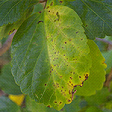 Hibiscus species
Hibiscus species
Hibiscus rosa-sinensis, Hibiscus syriacus and Hibiscus tiliaceus are susceptible to several fungal leaf spots including (Ascochyta abelmoschi), (Cerospora kellermanii) and (Phyllosticta hibiscina). All cause spotting or blotching of the leaf surface; remove and destroy infected parts.
Hydrangea species are infected by four fungal species including (Ascochyta hydrangeae), (Phyllosticta hydrangeae) and (Septoria hydrangeae).
Iris species are infected by several fungal leaf spots including (Alternaria iridicola) and (Macosphaerella species).
Iris species are also infected by the leaf spot (Didymellina macrospore) that forms greyish spots with brown water soaked borders and coalesce on the upper part of the leaf. This casual organism commonly occurs after flowering killing the leaves but will not infect the bulbs. The bulbs become weak over several seasons due to the decreased foliage.
There is also a Bacterial Leaf Spot (Bacterium tardicrescens) that is commonly mistaken as a fungal problem causing translucent spots that coalesce and involve the entire leaf. Normally found on Iris species.
Laburnum anagyroides is infected by the Leaf Spot (Phyllosticta cytisii). The leaf forms light grey spots with no definite margin and mature to brown. The black fruiting bodies appear as dots in the centre of the spot.
Leucanthemum species are infected by the leaf spot (Cerocspora chrysanthemi) and (Septoria leucanthemi).
Magnolia species are susceptible to many species including (Alternaria tenuis), (Mycosphaerella milleri) and (Phyllosticta species). Leaves generally turn brown from the apex or margins turning brown or spots appear on the leaf surface and leaves become yellow before withering and dieing. Normally the make the tree look poorly but have little effect on its growth. Control is not normally required.
Nerium oleander is susceptible to several fungal leaf spots including (Cercospora nerella), (Cercospora repens), (Gloesporium species) and (Phyllosticta nerii). Infected leaves should be removed but generally control is not required.
Nyssa sylvatica is infected by the leaf spot (Mycosphaerella nyssaecola) forming irregular purplish blotches.
Orchids such as Cattleya, Cymbidium, Cypripedium, Dendrobium, Epidendrum, Paphiopedilum, Phalaenopsis and Zygopetalum species are infected by several leaf spots including (Cerospora, Colletotrichum and Phyllosticta species). Normally forming dark or dead, circular or irregular areas on the leaves.
Palms such as Syagrus, Howea, Phoenix, Roystonea and Washingtonia species are infected by Leaf-scab (Graphiola phoeicis).
Palms such as Archontophoenix, Caryota, Chamaedorea, Cocos, Dypsis, Howea, Liculia, Linospadix, Livistona, Phoenix, Ptychosperma, Rhapis, Roystonea, Syagrus, Washingtonia and Wodyetia species are susceptible to several fungal leaf spots including;
(Bipolaris spp.), (Cylindrocladium spp.), (Colletotrichum spp.) and (Pestalotiopsis spp.).
Generally the circular leaf spots are brown and may have a yellow halo such as Palm Ring Spot (Bipolaris incurvata). They vary in size from small to large depending on the species. When a plant is healthy it recovers from attack, but heavy infections can defoliate, causing the collapse of the plant.
Palms are also infected by the Brachybasidium Leaf Spot (Brachybasidium pinangae). This fungus forms angular leaf lesions that produce fruiting bodies on the underside and is commonly found on Archontophoenix species.
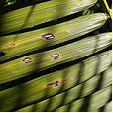
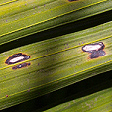 Archontophoenix cunninghamiana
Archontophoenix cunninghamiana
Passiflora species are infected with many types of leaf spot such as (Alternaria passiflorae).
Phoenix species are susceptible to False Smut (Graphiola phoenicis). This fungus forms yellow leaf spots that become hard with a raised with a blackish scab, which produces masses of powdery spores that are thread-like.
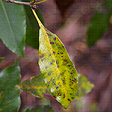
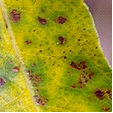 Pittosporum species
Pittosporum species
Pittosporum species are susceptible to the leaf spots (Alternaria tenuissima), (Phyllostica species) and (Cercospora pittospori). Circular or angular dark spots appear on the leaves and are surrounded by necrotic areas that are yellowish. Generally removal of infected leaves is adequate control.
Poa species and other cool season grasses are infected by Winter Fusarium Leaf Disease (Fusarium species), which causes small pale spots that are water soaked to appear on the leaves that turn red-brown. Infected leaves become bleached then wither and die, but the infection will not affect the crown or roots of the plant. It can be identified by pink, cotton-like mycelium and the plant prefers cold wet weather.
Populus species are infected by several fungal leaf spots including (Ciborinia bifrons, Ciborinia confundens), and (Mycosphaerella populicola).
Prunus species are infected by several leaf spots including (Cercospora circumscissa and Septoria ravenelii).
Pseudotsuga menziesii Douglas Fir is infected by the Leaf Cast (Rhabdocline pseudotsugae) Symptoms include the needles becoming yellowish at the apex and extending down the needle and spreading to others during moist spring weather turning them brown. Brownish scorched areas are noticeable on the tree from a distance. Control; is not normally required for mature trees but nursery stock may require spraying with a copper based fungicide.
Psidium guajava (Guava) is infected by (Glomerella cingulate). This fungus courses spots to appear on leaves and mummifies and blackens immature fruit or rots mature fruit. This fungus can devastate a guava crop.
Quercus species are infected by several types of leaf spot including (Cylindrosporium microspilum) and (Marssonina martini). These attacks tend top take place later in the season and normally not detrimental to the tree.
Rhododendron species are infected by a large variety of fungal leaf spots including (Cercospora rhododendri) and (lophodermium melaleucum)
Salix species are infected by several fungal leaf spots including (Ascochyta salicis) and (Septogloeum salicinum).
Senecio species are infected by the fungal leaf spot (Alternaria cinerariae) and (Cercospora species), forming dark rounded or angular spots.
Spiraea species are attacked by the fungal leaf spot (Cylindrosporium filipendulae).
Stenotaphrum secundatum (Buffalo) turf grass is susceptible to Grey Leaf Spot (Pyricularia grisea) in domestic and commercial situations devastating lawns. This fungal disease infects the stems and leaves with small brown lesions that enlarge rapidly forming grey-brown spots that have darker borders or surrounded by yellow chlorotic areas. This infection is commonly found on newly laid turf but will also infect established lawns. It is most prevalent during warm humid periods in soil with a high nitrogen level.
Syringa species are attacked by up to six species of leaf spot including (Cercospora lilacis) and (Phyllostica species).
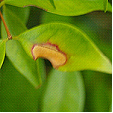 Syzygium species
Syzygium species
Syzygium species are infected by fungal leaf spots but normally control is not required.
Tagetes species are infected by the leaf spot (Septoria tageticola), which starts at the base and moves progressively up through the plant, covering the leaves in grey to black spots.
Trillium species are host to several leaf spots, including (Colletotrichum peckii) (Gloeosporium Trillii) (Heterosporium trillii).
Ulmus species are infected by many fungal leaf spots including (Gnomonia ulmea) and (Cercospora sphaeriaeformis).
Veronica species are infected by the leaf spot (Septoria veronicae). The symptoms include small violet to brown spots appear on the upper surface of the leaf and correspondingly yellowish brown on the underside. The spots converge forming a scorched shot-hole appearance and eventually death of the leaf.
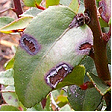 Vaccinium ovatum
Vaccinium ovatum
Vaccinium ovatum is infected by the leaf spot (Rhytisma vaccinii) and (Dothichiza caroliniana).
Vicia species are infected by the leaf spot (Erostrotheca multiformis), which forms greyish spots that enlarge and may defoliate the plant.
Wisteria species are infected by three fungal leaf spots (Phyllostica wisteriae), (Septoria wisteriae) and (Phomatospora wisteriae).
Non-chemical Control
Remove and destroy infected plant material and avoid overhead watering. When planting select infection resistant varieties. Practice crop rotation and add pot ash to the soil to decrease the plants venerability to the disease. Many species of fungus overwinter in fallen leaves, remove and destroy any litter under the plant.
Winter Fusarium Leaf Disease in Turf Grasses can be minimised by aerating the soil, reducing thatch and avoid excessive nitrogen in the soil.
Chemical Control
Protective fungicides such as zineb or copper oxychloride should be sprayed at the first sign of infection and cuttings should be sprayed as they start to grow.
Note
Always read the label for registration details and direction of use prior to application of any chemicals.
Average Lowest Temperature : -3º C 27º F
USDA : 8, 9, 10, 11
This USDA (United States Department of Agriculture) hardiness zone chart can be used to indicate a plant’s ability to withstand average minimum temperatures. However, other factors such as soil type, pH, and moisture, drainage, humidity and exposure to sun and wind will also have a direct effect on your plant’s survival. Use this chart only as a guide, always keep the other factors in mind when deciding where, when and what to plant.
A plant's individual USDA zone can be found in the Plant Overview.
Climate Description
Warm Temperate
This zone has the majority of rain during winter in the west and summer in the east with high humidity. Summer temperatures may peak at 40ºC (104ºF).
Frost and drought mainly occur inland and coastal wind is normally accompanied with rain.
Plant growth
Wide range of native and exotic plants grow well.
| Dictionary | Growth Habit |
| Leaf Type | Botanic Flower Description |
| Leaf Shape | Flower Inflorescence |
| Leaf Arrangement | Fruit Type |
| Leaf Margin | Bark Type |
| Leaf Apex And Bases | Flower Description |